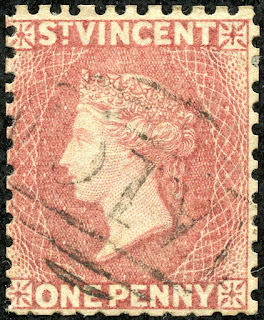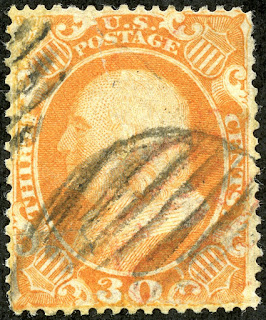Having acquired recently a rather nice classical era St. Vincent collection addition for Deep Blue, I thought I would do a deeper dive into the issues.
First, the reader might want to review the original blog post for a bit of background.
St. Vincent Blog Post & BB Checklist
The initial 1861-1881 issues with this post all feature the same engraved Perkins-Bacon (London) side-ways portrait of Queen Victoria. (A subsequent post will cover a bit of the later issues.)
The issues differ by perforation and no watermark vs watermark.
Let's take a look....
The first 1p rose stamp for St. Vincent was issued in 1861-62.
Scott separates out the 1861 stamp (Scott 1) as Perf 14-16, while the 1862 Scott 2 stamp is Perf 14-16, but rough. Both are CV $20 used.
Stanley Gibbons does not give separate catalogue numbers for the 1p 1861-62 Perf 14 to 16, but states that most perforations are "rough", but some are "intermediate".
Is my stamp above "rough" (Scott 2) or "intermediate"(Scott 1)?
Probably "rough".
A judgement call: Rough Perfs (1862 Scott 3- dark green, CV $21). If "Intermediate Perfs", then 1861 Scott 1B - yellow green CV $250.
A red cancel (fiscal?).
Between 1863-69, a group of stamps were perforated 11 to 13 (No Wmk).
Note: SG says the Perfs are 11 to 12 1/2.
The 1p rose has a CV of $22+.
There were three One Shilling stamps issued with Perf 11 to 13: 1866 1sh slate (CV $1,000), 1869 1sh indigo (CV $100), and 1869 1sh brown (CV $175). This is the brown one.
Between 1871-78, two stamps were issued with "Rough perf 14-16".
This is one of them. CV is $15+.
This is the other "Rough perf 14-16": dark blue green six pence.
CV is $77+.
Scott lists four stamps between 1872-1878 as "Clean-cut Perf 14-16".
I don't have 1877 Scott 15A 1sh vermilion - CV $50,000!
This 1p black might qualify (CV $15+) - but, if judged rough (Scott 13), would have the same CV.
The red cancel is probably used because this is a black stamp.
This might be the minor number (Scott 14Bc) color "dull blue green" - the major color (Scott 14B) is "deep blue green" Both have a CV of $55.
Obvious yellow-green. CV is $32.
This is a lively blue stamp (CV $100). The perf is 11 to 13.
CV is $55.
I would recommend also checking the SG catalogue, as they differ a bit with perf sizes.
CV is $100.
The vermilion color is susceptible to sulfuretting - note the darker color background around "St Vincent".
After H2O2 treatment- much better!
The orange color is also susceptible to sulfuretting. But this example looks good.
CV is $11+.
Not this one - note the darker brown color around the script.
Much better!
I only use 3% H2O2, and soak the stamp for the shortest time needed ( 60 seconds to 5 minutes). I then bath the stamp in warm water, and then dry it overnight
The Perf 11 to 13 stamps were issued between 1880-81.
This gray-green 1p is CV $5+.
A "drab" color! CV is $15+.
SG calls this "bright green". CV is $77.
Another sulfuretted specimen.
Looks good! CV is $65,
Another shade of the 1sh vermilion - more orange.
A Six Pence forgery: Most likely Spiro forgery.













































